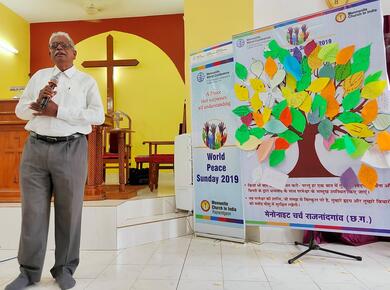Posted: September 16, 2022
India
The missionaries from USA started Mennonite mission work in central India, presently Chhattisgarh state in November 1899. They began with philanthropic works, providing relief to the drought-stricken people. The first baptism of 43 new converts was in December 1900. At the beginning, membership grew very rapidly. In 1949, when the Mission Work Golden Jubilee was celebrated, baptized membership was 1 579.
During the years following, MCI was not growing numerically as was hoped. Early MCI Indian leaders made some attempts to start new churches in new areas. Overall, however, having been satisfied with maintaining the status quo, MCI did no self-evaluation.
Possibly God was not satisfied with this maintenance of the status quo, and thus emerged the Pentecostal movement.
The coming of Pentecostals in MCI conference area
Before the 1970s, I remember some Pentecostal preachers were invited to preach at special occasions by local churches and also by the MCI Conference. They were mostly such preachers who could stir people emotionally.
In early 70s, Pentecostal presence was felt more in some urban Mennonite churches where membership was mixed from other denominations. In the main Mennonite church, Pentecostal worship services started in a private house in the mid-70s. Especially, the Mennonite youth who were not in the forefront of MCI activities started meeting for worship and fellowship in private houses. Non-Christians also started attending those Pentecostal house meetings.
The meetings were marked for their lively and emotionally charged singing and praying. Slowly the movement picked up momentum. New birth, immersion baptism, tithing and speaking in tongues were emphasized. People were encouraged to shout “Alleluia”, “Amen” and “Praise the Lord” during preaching. In worship services people were encouraged to share what the Lord had done in their lives during the previous week. At times, simple foods were freely served after worship services.
During weekdays, Pentecostal pastors regularly made house visitations, even in Mennonite houses. Praying for sick was boldly done. The pastors sought every opportunity to make their presence noted, like at funerals. They would often befriend well-off MCI members who were not very active in MCI churches. Slowly, Pentecostal house churches increased in numbers. They rapidly spread to more and more cities and villages and grew in numbers. The enthusiastic lay leaders were encouraged to attend Pentecostal Bible schools, and after completions they would be given congregations to serve.
It seems, there was not much institutionalized system. The pastors were the decision makers in all matters and free in running the local congregations.
MCI churches and Pentecostal presence
At first, though the church leaders invited distant Pentecostal preachers for preaching, the local Pentecostals were discouraged. Mennonite members who had joined Pentecostal movement were forced to leave Mennonite churches. But the persistent presence and increasing number of Pentecostals have changed the MCI thinking tacitly. Also many of MCI members married Pentecostal-background wives who have become active in the MCI churches.
Now the presence of Pentecostal churches and leaders are acknowledged and accepted. There is no more open rivalry between the two. In fact, the MCI has accepted changes in its own worship patterns. There is more singing in worship and people are invited to share what the Lord has been doing in their lives during the past week.
The Pentecostal pastors are accepted with due respect. Mennonite pastors are encouraged to pray for the non-Christians attending worship services afterwards. Prayer requests asked by the non-Christian are included in the pastoral prayers, and they are also allowed to share their testimonies in Sunday worship services.
This has encouraged unaffiliated village Pentecostal groups to seek MCI leadership. MCI on its part establishes those groups first as prayer centres and supporting the leaders there, and then, with certain conditions met, recognizes them as fullfledged MCI unit churches.
Some other attempts are also being made in MCI to rejuvenate members for evangelistic ministry.
Suggestions for relations with Pentecostals
1. Since this Pentecostal movement is a global phenomenon, we should accept it as God’s doing. We will do right to accept Jewish law teacher Professor Gamaliel’s advice mentioned in Acts 5:33-39.
2. We need to do self-evaluation, why God has raised the Pentecostalism in spite of the presence of the established churches. It is like the early 16th-century rise of the Anabaptist/Mennonite movement.
3. We should be able to rejoice in what God has been doing, bringing more and more people to Jesus Christ’s fold through the ministries of the Pentecostals.
4. The established churches should find ways to develop working relationships with the Pentecostals and other churches.
5. We should accept inadequacy of any one church denomination, including of MCI denomination, in not being alone able to proclaim the “manifold wisdom of God” (Ephesians 3:9-11). We need unity of spirit with and co-operations of churches for this calling.
— Shantkumar Kunjam is bishop of Mennonite Church in India Conference, and lives in Rajnandgaon, Chhatisgarh, India.



Join the Conversation on Social Media
FacebookTwitterInstagramFlickrYouTube